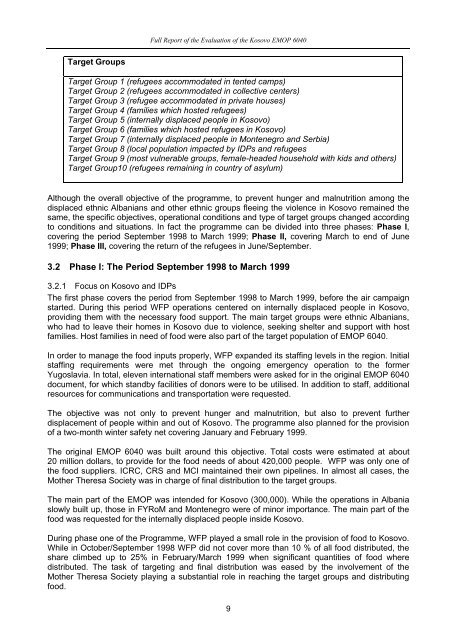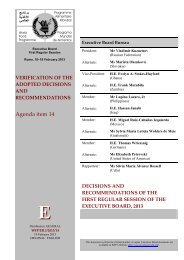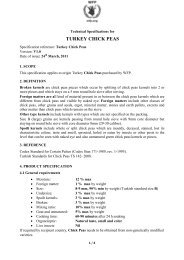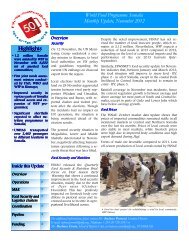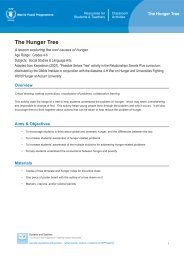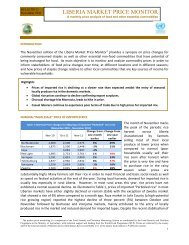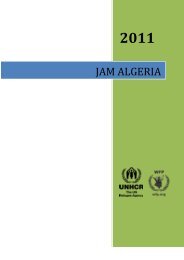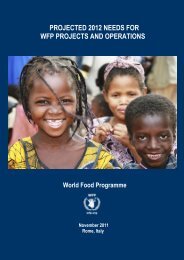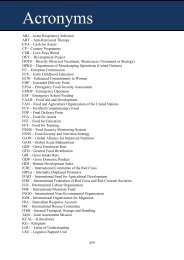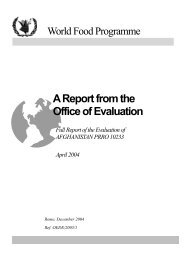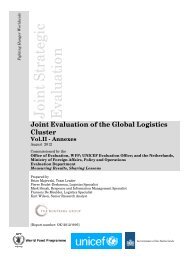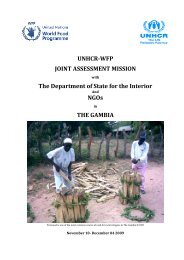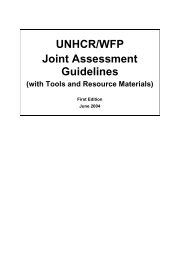Full Report - WFP Remote Access Secure Services
Full Report - WFP Remote Access Secure Services
Full Report - WFP Remote Access Secure Services
You also want an ePaper? Increase the reach of your titles
YUMPU automatically turns print PDFs into web optimized ePapers that Google loves.
Target Groups<br />
<strong>Full</strong> <strong>Report</strong> of the Evaluation of the Kosovo EMOP 6040<br />
Target Group 1 (refugees accommodated in tented camps)<br />
Target Group 2 (refugees accommodated in collective centers)<br />
Target Group 3 (refugee accommodated in private houses)<br />
Target Group 4 (families which hosted refugees)<br />
Target Group 5 (internally displaced people in Kosovo)<br />
Target Group 6 (families which hosted refugees in Kosovo)<br />
Target Group 7 (internally displaced people in Montenegro and Serbia)<br />
Target Group 8 (local population impacted by IDPs and refugees<br />
Target Group 9 (most vulnerable groups, female-headed household with kids and others)<br />
Target Group10 (refugees remaining in country of asylum)<br />
Although the overall objective of the programme, to prevent hunger and malnutrition among the<br />
displaced ethnic Albanians and other ethnic groups fleeing the violence in Kosovo remained the<br />
same, the specific objectives, operational conditions and type of target groups changed according<br />
to conditions and situations. In fact the programme can be divided into three phases: Phase I,<br />
covering the period September 1998 to March 1999; Phase II, covering March to end of June<br />
1999; Phase III, covering the return of the refugees in June/September.<br />
3.2 Phase I: The Period September 1998 to March 1999<br />
3.2.1 Focus on Kosovo and IDPs<br />
The first phase covers the period from September 1998 to March 1999, before the air campaign<br />
started. During this period <strong>WFP</strong> operations centered on internally displaced people in Kosovo,<br />
providing them with the necessary food support. The main target groups were ethnic Albanians,<br />
who had to leave their homes in Kosovo due to violence, seeking shelter and support with host<br />
families. Host families in need of food were also part of the target population of EMOP 6040.<br />
In order to manage the food inputs properly, <strong>WFP</strong> expanded its staffing levels in the region. Initial<br />
staffing requirements were met through the ongoing emergency operation to the former<br />
Yugoslavia. In total, eleven international staff members were asked for in the original EMOP 6040<br />
document, for which standby facilities of donors were to be utilised. In addition to staff, additional<br />
resources for communications and transportation were requested.<br />
The objective was not only to prevent hunger and malnutrition, but also to prevent further<br />
displacement of people within and out of Kosovo. The programme also planned for the provision<br />
of a two-month winter safety net covering January and February 1999.<br />
The original EMOP 6040 was built around this objective. Total costs were estimated at about<br />
20 million dollars, to provide for the food needs of about 420,000 people. <strong>WFP</strong> was only one of<br />
the food suppliers. ICRC, CRS and MCI maintained their own pipelines. In almost all cases, the<br />
Mother Theresa Society was in charge of final distribution to the target groups.<br />
The main part of the EMOP was intended for Kosovo (300,000). While the operations in Albania<br />
slowly built up, those in FYRoM and Montenegro were of minor importance. The main part of the<br />
food was requested for the internally displaced people inside Kosovo.<br />
During phase one of the Programme, <strong>WFP</strong> played a small role in the provision of food to Kosovo.<br />
While in October/September 1998 <strong>WFP</strong> did not cover more than 10 % of all food distributed, the<br />
share climbed up to 25% in February/March 1999 when significant quantities of food where<br />
distributed. The task of targeting and final distribution was eased by the involvement of the<br />
Mother Theresa Society playing a substantial role in reaching the target groups and distributing<br />
food.<br />
9


